Adventurous Kate contains affiliate links. If you make a purchase through these links, I will earn a commission at no extra cost to you. Thanks!
If you’ve explored enough of Santiago, but still need things to do, that’s quite all right — there are plenty of day trips from Santiago!
Whether you’re looking for mountains, beaches, vineyards, or natural wonders, you’ll find plenty to explore within a short driving distance of Santiago.
Planning your trip to Santiago last minute?
🏔️ Top-Rated Day Trips from Santiago:
- Visit Valparaiso and Viňa del Mar (My top recommendation!!)
- Maipo Valley Wine Tour (Fun wine-tasting day)
- Maipo Canyon and Hot Springs (Great active day trip)
🛌 Top-Rated Hotels in Santiago:
- Hotel Casa Real – Viña Santa Rita (Luxury wine estate outside the city)
- Hotel Boutique Casa Conde (Convenient location)
- BHB Hotel Boutique (Great budget option)
🚗 Renting a car from Santiago Airport? Find deals on car rental rates here.
While there are plenty of things to do in Santiago, the city isn’t necessarily a place you’d like to linger. It’s not one of the more exciting cities in Latin America, and you don’t need more than a day to take in the city’s best sights.
But day trips are where Santiago excels. The Andes are on your doorstep; multiple wine regions are just down the road. And the Pacific Ocean isn’t that far away, either.
Some of these day trips can be done by public transportation, while others are best done by guided day tours or by renting a car.
Let’s take a look at the best day trips from Santiago, Chile!
This post was published in April 2024 and was co-written by Adventurous Kate and Hannah Cooper.
Table of Contents
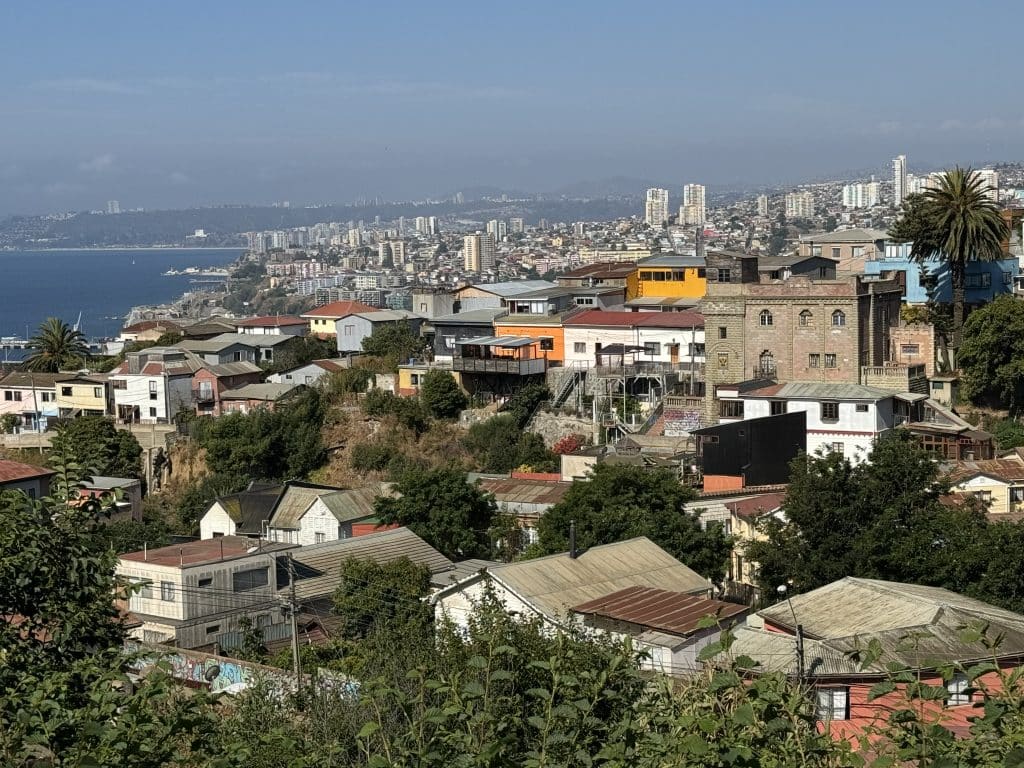
Best Day Trips from Santiago
Valparaíso
Valparaíso is a charming port city on the Chilean coast known for its colorful street art and kooky cafes. It’s a spirited place inhabited by students and young progressives with an emphasis on the arts (and ceviche).
I absolutely loved Valparaíso — I don’t think I’ve ever seen a city quite like it!
The UNESCO World Heritage Site of Valparaíso is built on around 40 hills. Fortunately for your legs, there are only two or three hills you’ll want to visit.
It’s easy to combine Valparaíso with its neighboring city, Viña del Mar. They’re only about 20 minutes apart.
Valparaíso is my top pick for day trips from Santiago, although I recommend you stay for a night if possible (I really loved my stay at the Hotel Winebox, a gorgeous boutique hotel full of art and incredible views from every angle!).
Best things to do in Valparaíso: One of the best things to do in Valparaíso is to roam the streets looking for art. You’ll want to make a beeline for Cerro Concepcion and Cerro Alegre. I was glad I did this with a guide, and this two-hour walking tour is a great option.
There are a couple of museums of note, including La Sebastiana, Pablo Neruda’s house, which I loved. A harbor boat ride is fun, as it lets you see the layout of the city.
Should you book a tour or go independently: You could go either way. There are plenty of buses from Santiago to Valparaíso that run all day. But if you want to include both Valparaíso and Viña Del Mar, I recommend you book a guided tour, as there are more moving parts to manage.
Book a tour to Valparaíso: This full-day guided tour to Viña del Mar and Valparaíso invites you to take in the city of culture and its trendy twin. After pausing in the Casablanca Valley, you’ll be ushered around the highlights of Valparaíso before being dropped in Viña del Mar for solo exploration.
How to get from Santiago to Valparaíso independently: Buses depart from Terminal Alameda and Pajaritos Metro Station every 10 minutes during the day. Journey time is 2 hours from Alameda and 1 hour 40 minutes from Pajaritos. Tickets are sold via the Turbus, FlixBus, and ChileBus websites (use these sites for all destinations).
Drive time is just under 1.5 hours. I don’t recommend driving to Valparaíso, as parking is difficult and rental cars are targeted by thieves.
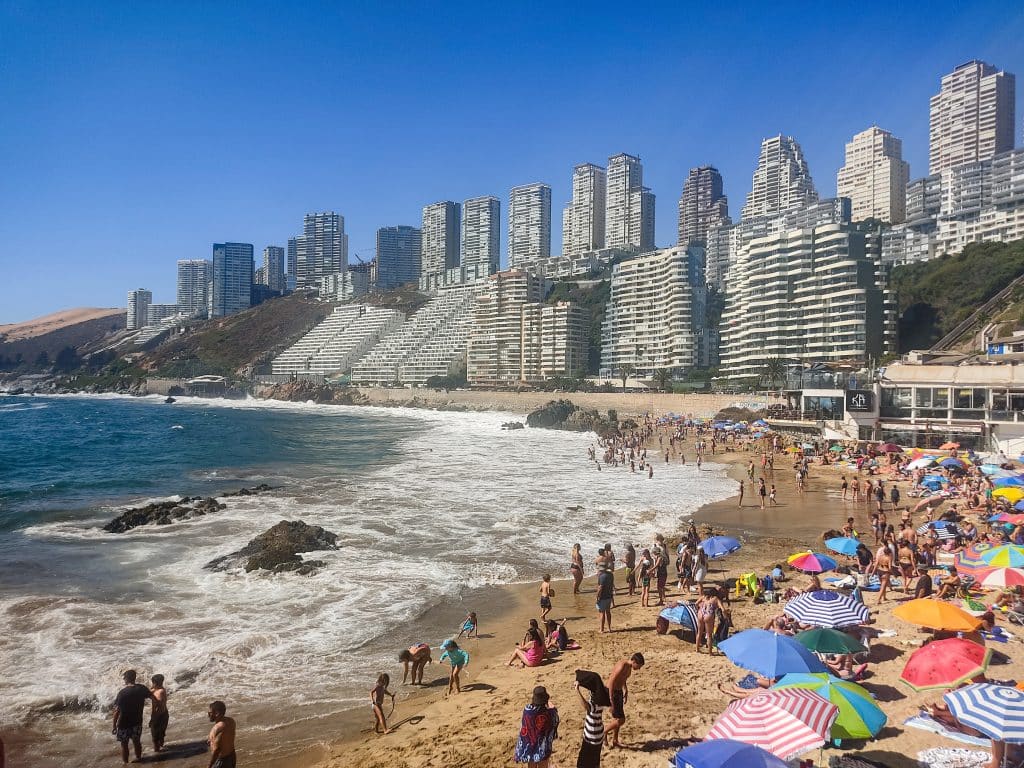
Viña del Mar
Viña del Mar is an affluent yet laid-back coastal city with sweeping sandy beaches and a classy dining scene. It’s known as the Garden City due to its botanical gardens although the name means “Vineyard of the Sea.”
The city is overwhelmed with sunbathing Chilean and Latin American tourists between December and February. It’s calmer during shoulder season and a virtual ghost town in winter. But it never gets very cold here, and winter is better for spotting seals.
Viña del Mar and Valparaíso are very different, but work so well together as a double-header! Consider splitting the day between the twin cities.
Best things to do in Viña del Mar: Hang out on the beach. Swimming is prohibited due to the strong currents (plus, the water is freezing, despite those people you see in the photo above) but it’s perfect for sunbathing, walking along the promenade, and watching the sunset.
Follow the coastal path north to Reñaca and see the Concon Dunes. If you speak Spanish, you can take a bus (known as micros); otherwise, hail an Uber.
Should you book a tour or go independently: Exactly the same as Valparaíso. If you’re planning a day trip just to Viña del Mar, it’s easy enough to get there by bus on your own. If visiting both cities, take a tour.
Book a tour to Viña del Mar: This full-day tour of Valparaíso Port and Viña del Mar starts in the Garden City, where you’ll see such monuments as the Moai from Easter Island and the famous Flower Clock. After lunch, the tour continues to Valparaíso.
How to get from Santiago to Viña del Mar independently: Same as Valparaíso, buses depart from Terminal Alameda and Pajaritos Metro Station every 10 minutes. Journey time is two hours from Alameda and 1 hour 40 minutes from Pajaritos.
Driving takes 1.5 hours. Parking is a nightmare in summer — limited and super tight!
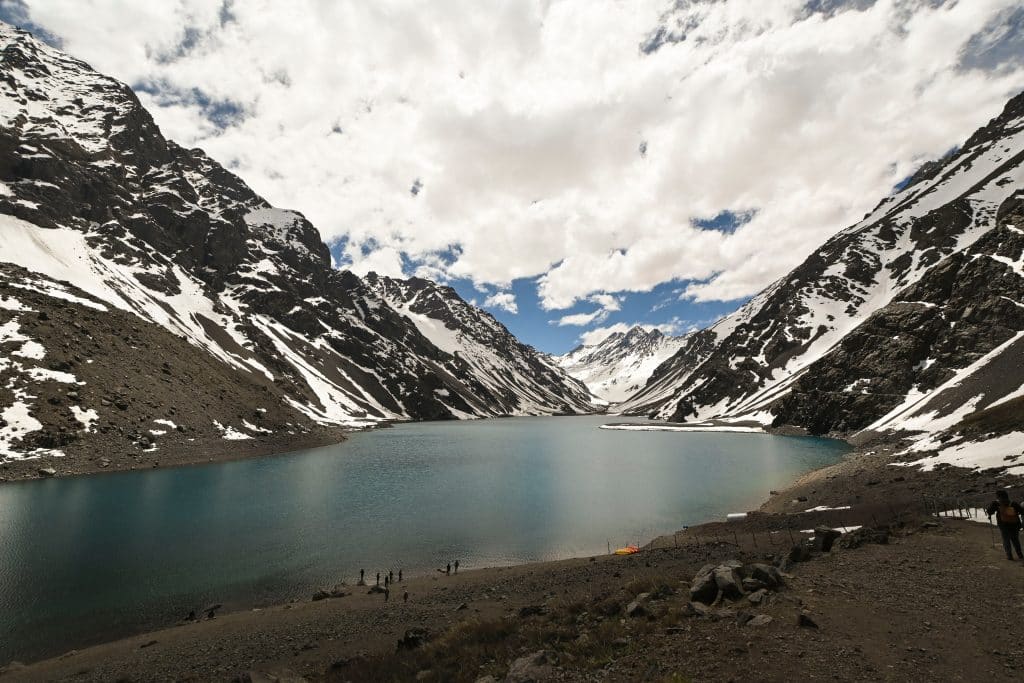
Inca Lagoon
The Inca Lagoon (Laguna del Inca) sits at an imposing 2,853 meters in the Andes mountains. Aquamarine waters sparkle under the sunshine or provide a winter wonderland in winter after snow blankets the ranges.
The route to the lake is via the Paso Internacional Los Libertadores and means braving Los Caracoles — the snail road. This segment ascends to the land border with Argentina and has 29 steep hairpin turns!
All in all, this is one of the best day trips from Santiago for stunning mountain scenery. If you’re not going to Patagonia on your Chilean adventure, this will scratch your mountains-and-lakes itch.
Best things to do in Inca Lagoon: Admire and photograph the landscape. It snows between June and September, so you could go skiing at Portillo if you’d like. As long as you’re not driving, it’s possible to stop for a wine tasting in the area.
Should you book a tour or go independently: I recommend booking a tour. The road is in good condition but it’s very narrow and windy in places, and better left to locals.
Book a tour to Inca Lagoon: This day trip to the Inca Lagoon includes round travel from Santiago. You’ll stop for a wine tasting near San Esteban and meet llamas in Guardia Vieja.
How to get from Santiago to Inca Lagoon independently: No public transportation goes here. If you are comfortable driving, anticipate three hours each way (91 miles).
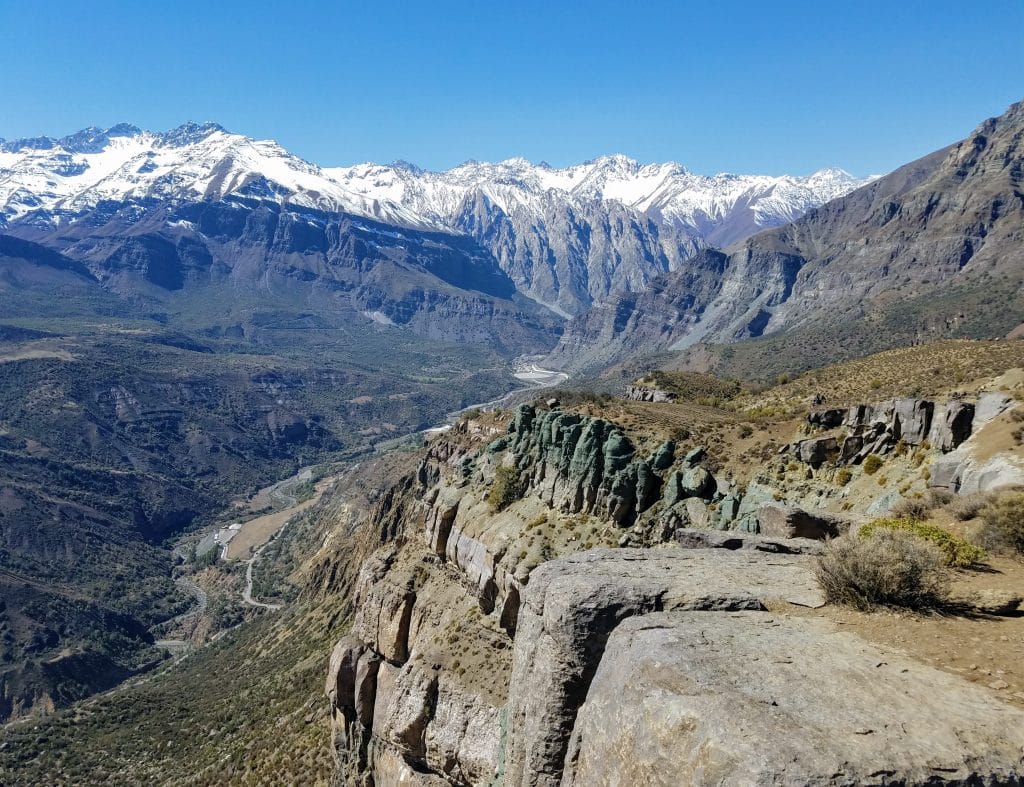
El Cajón del Maipo
The stunning el Cajón del Maipo, or Maipo Canyon, is another of the best places near Santiago for nature. It’s a stunning gorge along the Maipo River in the foothills of the Andes.
This glacial canyon and river gorge is a hub for outdoor activities like rafting, horseback riding, kayaking, and hiking.
Best things to do in Cajón del Maipo: Go whitewater rafting! Cascada de las Ánimas has a fleet of Hypalon rafts and provides all the gear to ensure safety and fun.
Otherwise, you can pick from hiking the river gorge, seeing the San Francisco glacier and el Morado Natural Monument, and soaking in the thermal baths.
Should you book a tour or go independently: A tour guide is required for most activities, and the public transit journey here from Santiago is a bit hairy, even if you speak Spanish. You’ll want to book one of the tours below, or book with Cascada de las Ánimas.
Book a tour to Cajón del Maipo: A guided hike to Cajón del Maipo and Volcán San José immerses you in this beautiful area. The 5-mile (8 km) track is graded easy to intermediate and the bilingual tour guide ensures the pace accommodates the whole group.
Alternatively, this Maipo Canyon, volcano, and hot spring tour starts with a shorter hike. After finishing the walk, you’ll enjoy a glass of wine before bathing in the sizzling hot springs of Baños Colina.
How to get from Santiago to El Cajón del Maipo independently: Ride Metro Line 4 to the terminus station, Plaza de Puente Alto, and get an Uber from there. But be sure you have a way of getting picked up, too.
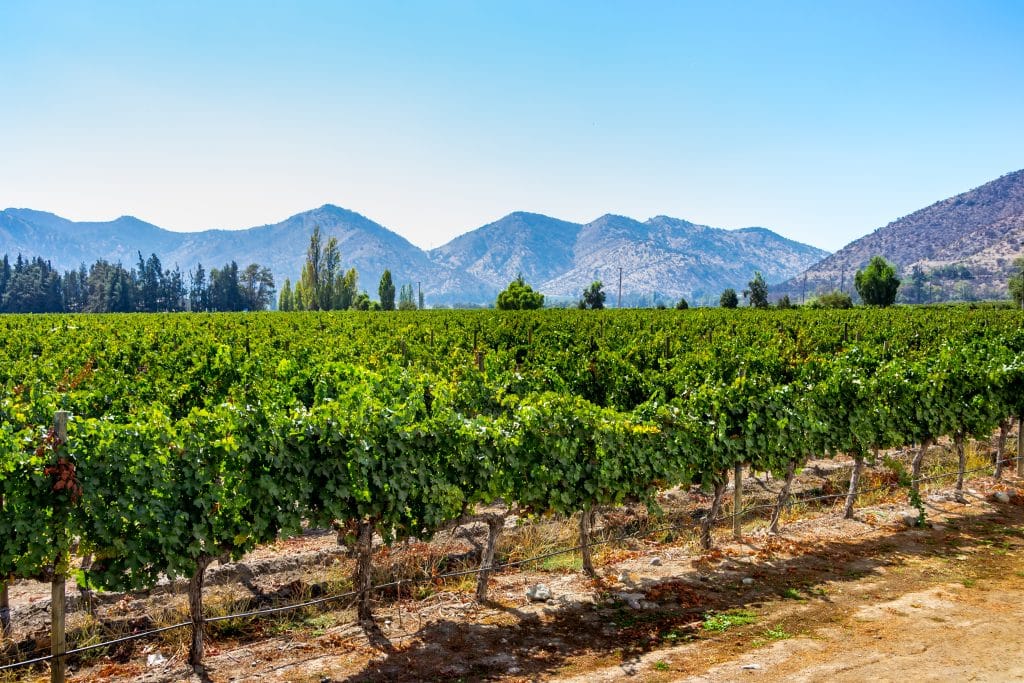
Maipo Valley Wine Region
The Maipo Valley is one of the best day trips from Santiago for red wine lovers. It’s also the closest wine region — if you’re eyeing up the Colchagua Valley, that’s a 2.5-hour drive away, which I think it a bit too far for a day trip.
The high altitude of the Maipo Valley results in particularly aromatic Cabernet Sauvignon and Carménère wines. There are around 16 wineries in this part of the Central Valley.
Concha y Toro is one of the largest wine producers in the whole of South America. It’s known for Casillero del Diablo which handsome man Pedro Pascal has recently become the face of. I’d encourage choosing smaller wineries for a more intimate experience.
Best things to do in Maipo Valley: Tasting wine is the reason to visit! Even if you’re the designated driver, you can still tour the vineyards, learn about production techniques, and buy a bottle to take home.
Furthermore, non-drinkers and children will enjoy the Maipo Valley for its bucolic landscapes.
Should you book a tour or go independently: Renting a car and driving around the Maipo Valley is a lot of fun. However, you then can’t partake in wine tastings — Chile has strict laws about driving under the influence. A tour will allow you to enjoy the wines worry-free.
Book a tour to Maipo Valley: This Maipo Valley Wine Tour from Santiago whisks you to four vineyards where you’ll sip premium reds and pisco while learning about rural life in Chile.
This top-rated Cajon del Maipo tour is a great way to combine the river gorge with the wine region. You’ll see highlights on the way to the Embalse El Yeso (El Yeso Dam) where you’ll dine at a local restaurant and taste the region’s Cabernet Sauvignon.
How to get from Santiago to Maipo Valley independently: If you want to just visit Concha y Toro, take Metro Line 4 to Plaza de Puente Alto and hail an Uber. You’d need to rent a car or book a private driver to fully explore the Maipo Valley. It takes around one hour to reach the valley from Santiago.
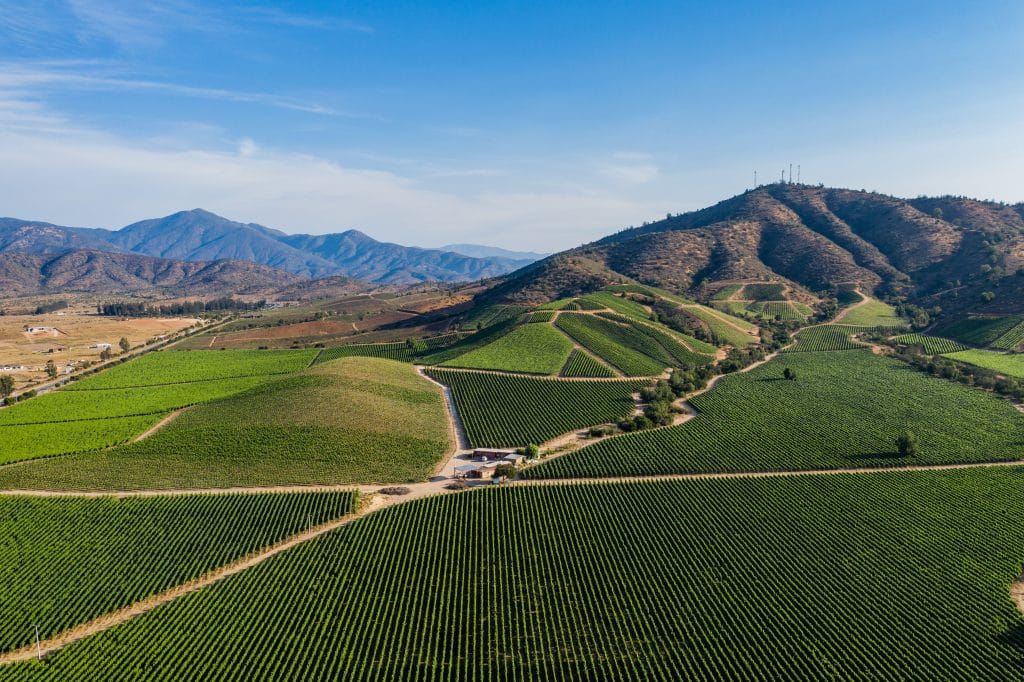
Casablanca Valley
Continue your wine education in the Casablanca Valley, where white wines are the stars. This wine region is closer to the Pacific Ocean, which results in crisp Sauvignon Blanc and Chardonnay wines that impress even the most loyal red drinkers (that would be me and my husband).
The climate is cooler, and it’s a refreshing place to visit on a summer day. There are around 13 wineries to pick from. Viña Indomita is one of the most iconic, also revered for its Pinot Noir and castle-like exterior.
Many tours to Valparaíso and Viña del Mar stop in the Casablanca Valley.
Best things to do in Casablanca Valley: Much as with the Maipo Valley, the focus is on wine tastings and learning about viticulture. Visit Santa Rita for the wine and also to wander the lush gardens.
If you go independently, stop off at Curacaví. It’s a quintessential small town typical of rural Chile. You can also visit a brewery, Cervecería Kross, which has an awesome garden, too!
Should you book a tour or go independently: Same as Maipo Valley: either have a designated driver or book a tour.
Book a tour to Casablanca Valley: This small-group tour to the Casablanca Valley takes you to three wineries where you’ll swirl whites and sparkling wines. Lunch (extra cost) is booked at the gastronomic Tanino.
How to get from Santiago to Casablanca Valley independently: The Casablanca Valley is an easy drive west along Ruta 68. It takes 45 minutes to reach the valley from where you’ll drive around the wineries.
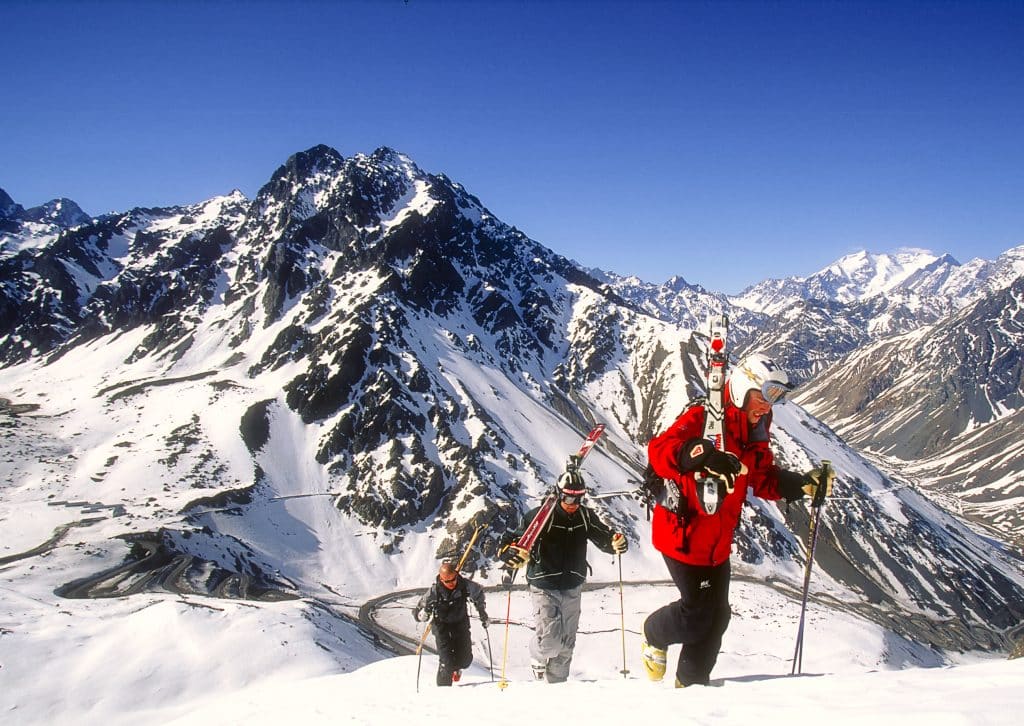
Nearby Mountain Resorts
Leave the bustle of the city far behind and climb up into the mountain resorts near Santiago de Chile. Activities are seasonal and the Andean landscape never disappoints.
Ski Portillo claims the slopes near the Inca Lagoon and is suitable for beginners and pros. Valle Nevado and Farellones are closer when planning a skiing day trip from Santiago. Lessons, equipment hire, and transfers are all available.
Best things to do in the mountains: Go skiing, snowboarding, and tubing from June through September. Summer is for hiking, mountain biking, and zip-wiring. It’s nice to visit purely for the scenery.
Should you book a tour or go independently: Going alone allows for more flexibility and the resorts make it easy to book activities.
Book a tour: This small-group tour to Valle Nevado and Farellones is available as a sightseeing excursion. Skiing is an extra cost.
How to get there independently: It takes 1 hour and 30 minutes to drive to Farellones and Valle Nevado. It’s three hours to Portillo (via Los Caracoles and Los Libertadores). The ski resorts arrange official transportation in winter or you can book a Ski Total package.
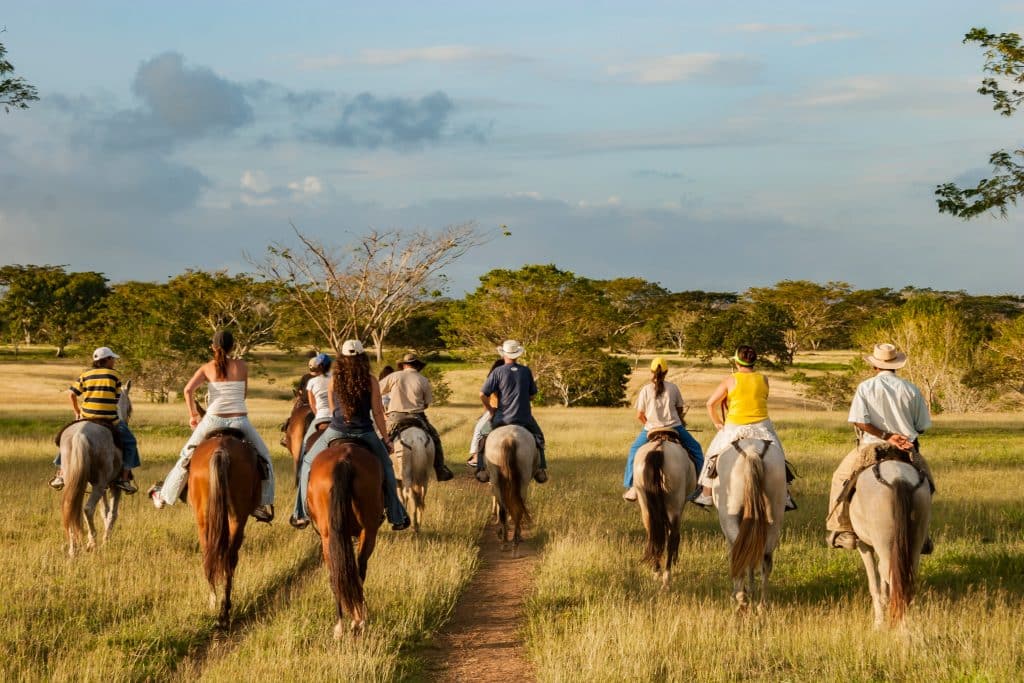
Horseback Riding
The gorgeous hills around Santiago are a great place to saddle up and go horseback riding! As with the United States, much of the Chilean wilderness is only accessible via foot (or hoof).
Cabalgatas Santiago is a highly-rated provider of horse trekking tours. Shorter routes take 1.5 or 2.5 hours while others exceed four hours. Helmets are provided and the tours are suitable for non-riders. Younger children are welcome on a case-by-case basis; talk to them in advance. All horses are placid and good-natured.
The website is a little glitchy but you can email the stable manager or write to her on WhatsApp. (Note to Americans: the rest of the world uses WhatsApp for texting, and I highly recommend you get an account before you go to Chile, or anywhere else!)
How to get from Santiago to Cabalgatas: Ride Metro Line 1 to Los Dominicos then hail an Uber for the final stretch. The stable manager arranges taxis from the center of Santiago.
Reserva Nacional Río Clarillo
The Reserva Nacional Río Clarillo comprises Andean forestry, mountain peaks, and river ecosystems. It shelters such species as foxes and eagles and is the perfect place to stretch your legs with minimal effort.
Three trails are currently open although this changes every season. As a national park, these are sign-posted and well-cared for.
Admission is 14,000 CLP ($14.50 USD) and payable in cash at the picnic area or online. It’s closed on Mondays and high temperatures mean it sometimes closes for extra days in summer. Shoulder season is the best time to visit.
Best things to do in Río Clarillo: Hike the short and easy Quebrada Jorquera circular. The Trikau and Arboretum trails are tougher options. Tours aren’t available but the visitor center has maps to help you plan your adventure.
Tandem skydive over the park with Skydive Santiago.
How to get from Santiago to Río Clarillo independently: Ride Line 4 to Plaza Puente Alto and Uber from there to the park entrance.
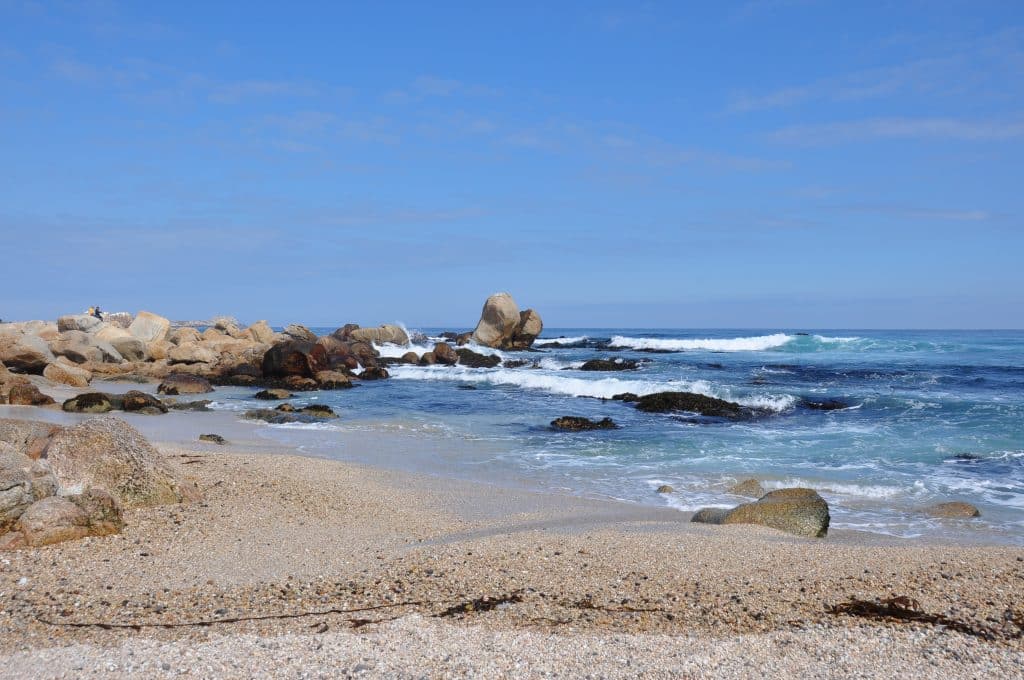
Isla Negra
If you walked west from Santiago in a straight line, you’d eventually wind up in Isla Negra. Despite the name – “Black Island” – it’s on the mainland. The name refers to the jet-black boulders strewn along the beaches.
Isla Negra is associated with the Chilean poet and Nobel Prize winner Pablo Neruda who made the town his home. It’s just one small seaside town on the Coast of the Poets (el Litoral de los Poetas).
Best things to do in Isla Negra: Visit Casa de Isla Negra. Pablo Neruda’s house (and resting place) sits on an outcrop by the beach and exhibits his possessions.
There’s usually an artisanal open-air market outside where you can buy trinkets and jewelry.
Follow the road marked “Poeta Neruda” north to Punta de Tralca. This leads you to a nature reserve on the headland with amazing views.
Should you book a tour or go independently: A tour isn’t necessary for Isla Negra, but it’s a good way to maximize an outing and reduce congestion in these small towns.
Book a tour to Isla Negra: This private tour to Isla Negra also takes you to El Tabo, Algarrobo, and Canelo. These towns couldn’t be more different.
This full-day tour to Isla Negra, Algarrobo, and Undurraga Winery focuses on Neruda’s town and the bustling Algarrobo which stages the world’s largest swimming pool. Bonus points for calling in at one of the country’s oldest wineries.
How to get from Santiago to Isla Negra independently: Buses bound for El Tabo usually stop at Isla Negra, but you’ll need to tell the driver before boarding. It takes just under two hours. The Coast of the Poets is fun to drive around but parking is scarce in summer — stick to the bus in high season.
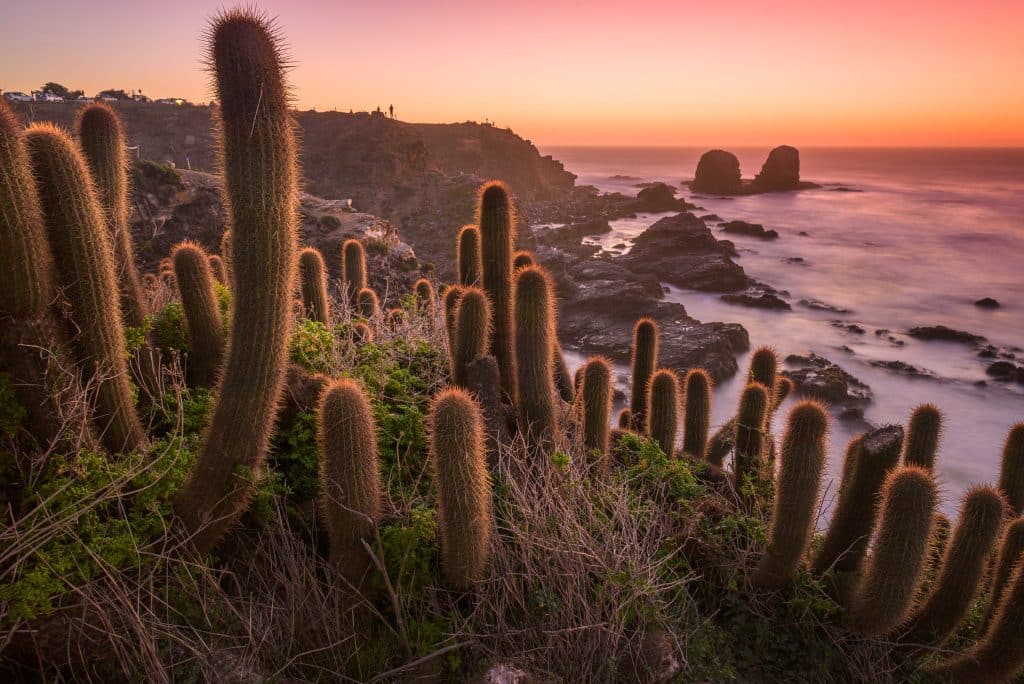
Pichilemu
Pichilemu is another small beach town on the Pacific coast. The sand is black and the surf is strong — it’s one of the best places in Chile for surfing.
The town is typical of a surf town: casual, hippy-ish, and unpretentious. It’s quieter than Valparaíso and less polished than Viña del Mar, but with the same epic food scene of empanadas and seafood.
Due to the distance, this is one of the more ambitious day trips from Santiago. I recommend staying overnight if possible; otherwise, it will be a long day.
Best things to do in Pichilemu: Surf. The water is warmer and the waves are calmer in summer whereas winter brings challenging conditions. Infiernillo is strictly for pros, whereas newbies can surf at the main beach.
Punta de Lobos is worth a visit to watch people riding the waves. Conditions are mixed with spots for first-timers and experienced surfers. It’s 4.5 miles south of town so a rental car is handy. Otherwise, you can hail a cab (there’s no Uber in Pichilemu!).
Should you book a tour or go independently: Tours aren’t an option so you’ll need to go it alone. Renting a car is a good idea, as it’s faster and you can stop in the Colchagua Valley, which I really enjoyed visiting.
How to get from Santiago to Pichilemu independently: The fastest buses take 3.5 hours and the longest take five. Driving takes three hours each way.
More on Chile:
- 17 Best Things to Do in Santiago, Chile
- 15 Best Things to Do in Puerto Varas, Chile
- 17 Colorful Things to Do in Valparaíso, Chile
- 26 Fun Things to Do in San Pedro de Atacama, Chile
- Staying at Ecocamp Patagonia: A Sustainable Resort in Chile
More on South America:
- 32+ Fun Things to Do in Buenos Aires, Argentina
- 25 Epic Things To Do in El Calafate, Argentina
- 18 Wild Things to Do in El Chaltén, Argentina
- El Calafate vs. El Chaltén: Which Town in Argentine Patagonia is Better?
- 16 Epic Things to Do in Ushuaia, Argentina
- Solo Female Travel in Colombia: Is it safe?
- What’s it really like to travel to Guyana?
Have you been to Chile? Where did you enjoy visiting? Share away!